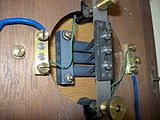Carbon microphone
The carbon microphone is a microphone whose electroacoustic transducer principle is based on the fact that pressure fluctuations caused by sound cause changes in the electrical contact resistance of graphite particles between its connections. Carbon microphones are rarely used these days.
history
The first microphone that enabled voice telephony was developed independently by David Edward Hughes in England and Emil Berliner and Thomas Alva Edison in the USA . Although Edison was the first to apply for a patent, Hughes had shown a working prototype a few years earlier to numerous witnesses, so that most historians see Hughes as the inventor of the carbon microphone.
Coal meal microphone
The pressure-dependent contact resistance between carbon particles ( coal granulate, coal grit), which are compressed by a sound-receiving sheet metal membrane, is used for conversion .
construction
A sound-permeable housing is closed on one side with a metallic membrane . This forms one electrode . It is filled with charcoal grits made from anthracite . The counter electrode is on the other side.
function
A DC voltage must be applied between the membrane and the counter electrode via a working resistor ( consumer ) . The sound waves are transmitted through the membrane to the charcoal. The principle is based on a " loose contact " between the grains of coal. The microscopic changes in position of the particles cause a modulation of the direct current flowing through them . The pressure-dependent contact resistance typical of graphite also plays a role here.
In telephones, the working resistance can be directly on the earpiece (electromagnetic converter) - amplification is only necessary for longer transmission distances.
Different application requirements can be met to a certain extent by using different grain sizes .
commitment
Coal semolina microphones were used in large numbers in telephones until the 1970s . It is believed that the invention of the carbon microphone greatly accelerated the development of telephony. The speech intelligibility was thus sufficiently good. In the 1960s and 1970s, the carbon microphones in telecommunications technology were replaced by the acoustically better dynamic microphones, but especially piezo microphones, which in turn made way for the electret condenser microphone in the 1980s , which integrated the necessary amplifier electronics. As before, the operating voltage is obtained from the connection cable. This means that carbon microphones in telephones can usually be replaced 1: 1 by electronic variants.
In the sound engineering or music recordings carbon microphones are not used due to the low quality of reproduction. In professional sound engineering, the carbon microphone was replaced by the condenser microphone as early as the 1920s and 1930s . Today, dynamic microphones and condenser microphones are used in more sophisticated audio technology.
Carbon microphones were also used as larynx microphones and for direct modulation of tube- equipped transmitters.
In early telephone transmission lines, carbon microphones were used as repeaters because of their amplifying properties . A kind of loudspeaker was mechanically coupled with the microphone. The transmission quality was poor, but the technology made long-distance calls possible even before the introduction of the electron tube (around the 1920s). Until the 1950s, such amplifiers were also used in hearing aids , as the power supply was much lighter and simpler than with electron tubes.
Designs
Instead of the charcoal, discrete graphite parts were used, which are moved towards each other by the sound - in the model on the left from 1889, small graphite rolls suspended on pins and moved by springs relative to a wooden membrane are used.
properties
Positive characteristics:
- High electrical output level, which means that additional amplification is usually not required; Can be switched directly in series with the earpiece
- Reinforcing properties
- Low production costs
Negative characteristics:
- Strong noise due to oxidation processes at the tips of the coal grits; age dependent
- Distortion factor often over 5 percent
- Poorly reproducible transmission properties, position and vibration dependent
- Maintenance-intensive or limited service life
- Highly moisture-dependent parameters
literature
- Harry Dittrich, Günther Krumm: Elektro-Werkkunde Volume 5 / Professional experience for telecommunications fitters and telecommunications mechanics. 4th edition, Winklers Verlag, Darmstadt, 1971
- The big book of technology. Publishing house for knowledge and education, Bertelsmann GmbH publishing group, Gütersloh, 1972
- Helmut Röder, Heinz Ruckriegel, Heinz Häberle: Electronics 3rd part, communications electronics , 5th edition. Verlag Europa-Lehrmittel, Wuppertal, 1980, ISBN 3-8085-3225-4
Web links
Individual evidence
- ↑ Bob Estreich: Professor David Hughes (Eng.)
- ↑ Encyclopedia Britannica: David-Hughes (Engl.)
- ↑ Thomas Görne, Microphones in Theory and Practice, 2nd edition 1996, page 59
- ^ The Gallery of Electro-Mechanical Amplifiers





